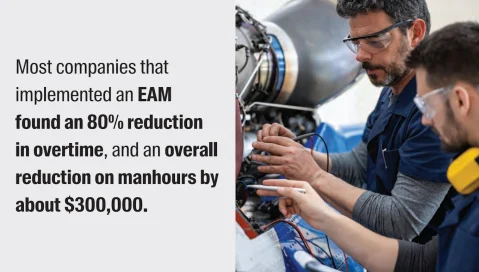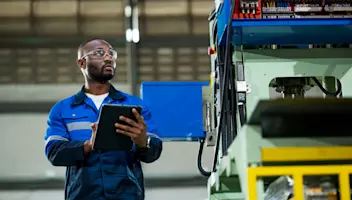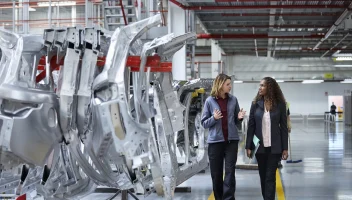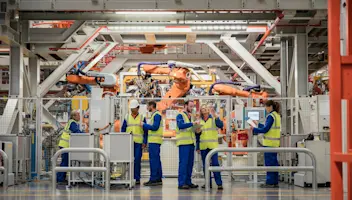Uitgelicht in deze blog
Your Ultimate Guide To Preventive Maintenance and Managing Costs in Manufacturing
Your Ultimate Guide To Preventive Maintenance and Managing Costs in Manufacturing
5 Jan 2024
Aptean Staff Writer
If you’re in manufacturing of any kind, a significant part of your company’s capital is tied up in assets—that is, property, machines and equipment—and you need an efficient, reliable way to track, manage and maintain all of these assets. Sure, you can muddle through with spreadsheets and reams of paperwork, but why would you, when there is a system that can do that for you? Enter enterprise asset management (EAM) software.
EAM is defined as the process of tracking and managing physical assets, such as machines, equipment and buildings throughout their lifecycle.
Therefore, EAM software is an invaluable tool to help manufacturers optimize that process. With the system you're able to better plan, optimize, execute and track all maintenance activities and oversee the associated schedules, contacts, materials, tools and all other information. Furthermore, EAM software enables you to execute preventive maintenance and effectively maintain, analyze and trigger maintenance requests, as well as organize work orders—keeping your technicians accountable and increasing maintenance efficiency.
With rising inflation, it costs more than ever to run your business. Additionally, failure to manage and maintain enterprise assets can lead to suboptimal asset performance which in turn may lead to supply shortages. As a result, you're under constant pressure to get the most out of your current assets, meaning you must make quick and sometimes difficult decisions about your operation. The answer to all these challenges? EAM software.
A powerful EAM will increase performance and uptime of your physical assets and extend the useful life of these assets—reducing operational costs right out of the gate.
Most companies that adopted an EAM system saw a reduction in operating costs between 8 and 20%. After adding an EAM, the cost of spare parts went down by an average of 23%.
But there are other benefits, too. Well-maintained machines don’t break down as often, so there's less risk of safety issues. Plus, all activities related to asset management are housed in one centralized platform, so you get a 360-degree view of your assets across all locations and every department.
EAM streamlines the processes associated with managing the lifecycle of assets and helps maximize their use. You can automate work orders, contracts, tech manuals, maintenance schedules and more. If you're running an outdated legacy maintenance solution or trying to manage these processes manually, it can create downtime, which gets expensive quickly. The average cost of one downtime incident costs an average of $17,000 per year.
Instead, EAM uses real-time data and analytics to help decision-makers manage the reliability and maintenance of their assets. To remain competitive, you need proven methods to get the most out of your current assets, avoid downtime and plan for contingencies. EAM can help you do all that and more.
In this blog, we’ll discuss how EAM helps you stay on top of asset maintenance and save money as you develop a long-term, proactive maintenance strategy.
Failure of major assets could mean the loss of millions for your company. In fact, unplanned downtime averages out to some $14 million lost every year.
Is Your Maintenance Solution Working for You — or Against You?
If you’re running an outdated maintenance system, you won’t have real-time visibility. Maybe you’ve gone through some changes recently, like rapid growth; or maybe you’ve moved into a new facility. If your current solution can’t scale to meet your company’s expansion, it means that it's falling behind. Most likely, your maintenance activities will fall behind, also.
Here are four signs that it’s time to replace your maintenance solution.
1. You Don’t Have Full Visibility of All Assets
Your maintenance solutions should allow managers and technicians to track and check the status of assets at every facility. You should be able to find real-time equipment metrics such as failure codes, parts inventory, equipment status and completed work orders. Without real-time visibility, it’s hard to make smart, data-driven decisions to keep everything at peak efficiency.
2. You Can’t Keep Up With Compliance
Whether or not you have a maintenance solution, you know that you must track the warranties, inspections, maintenance and repair logs of every piece of equipment. If you must do some (or all) of this process manually, you may not be keeping up with compliance codes and industry regulations. And even if you are, it's probably taking you longer and costing you more than it needs to. A comprehensive maintenance solution can automate most compliance tasks by setting notifications, scheduling routine maintenance and tracking repair logs. All important documents are stored in one central database. This saves time, boosts compliance and makes inspections and audits a snap because everything is fully documented and easily accessible. Can your current solution do that?
3. Your Team Is Still Using Outdated, Manual Processes
How do your tech teams manage paperwork? If they must use paper forms at any point during repair and maintenance activities, your maintenance solution needs to go. Paper processes mean more work, and are also prone to human errors, as they must be input into your system after the work has been completed. You need a cloud-based maintenance solution where all documents are stored online. This means that your team can fill in any logs or forms electronically and everyone has access to real-time information.
4. Your Maintenance Is Falling Behind
If you are trying to manage work orders, but they are getting backed up, it’s probably time to get a new maintenance solution. It means that your current processes to manage maintenance activities and work orders are insufficient, and your team doesn’t have the right information accessible to them. A robust EAM solution has a centralized database to store asset management, inventory management, work order management and preventive maintenance management data. Both supervisors and the maintenance crew will always have the necessary parts and equipment available to finish a work order.
Every physical asset or piece of equipment you own requires routine maintenance to keep it running at peak performance. With EAM software, you can integrate processes across every facility for maintenance planning, scheduling and execution.
If your current maintenance software can’t do that, it’s time to find a new solution.
Almost 70% of manufacturing companies don’t know when their equipment is due for maintenance.
What Is Preventive Maintenance?
You’ve read this far into the blog, and maybe you’ve realized that your current maintenance strategy isn’t working. You’d like to start a new cost-cutting maintenance program, but you aren’t sure where to begin. Most companies without EAM software are working on an inefficient, reactive break/fix cycle. Not only is this type of cycle ineffective, but it also wastes both time and money.
An effective maintenance strategy commences with preventive maintenance (PM). Preventive maintenance, sometimes called proactive maintenance, encompasses the routine, planned maintenance of assets and equipment on a set schedule. This type of plan reduces equipment failure, maximizes uptime and optimizes long-term asset management.
In today’s fast-paced competitive environment, you need continuous production and equipment uptime for your organization’s overall success. An efficient, automated maintenance plan is the only way to achieve it.
To reiterate, preventive maintenance is a planned, scheduled set of maintenance activities that helps prevent unexpected failures in the future. It’s sort of like getting regular oil changes and tune-ups for your car—you want to keep things running as smoothly as possible. It’s a viable plan that’s all about fixing things before they break. Think about it—if someone is inspecting and troubleshooting machines on a regular basis, chances are that they will notice issues before they arise.
If your company is a part of that 70% and you are blindly following a reactive maintenance schedule, you aren’t using your equipment and assets effectively, and you might be setting yourself up for catastrophic failure. However, if you are using an EAM, you’ll have the data you need to develop preset maintenance schedules and correct any issues. You’ll know when your equipment is due for maintenance, and you can automate, access and organize your PM tasks. This is crucial for asset-intensive organizations with complex maintenance schedules. Preventive maintenance can slow down failures, depreciation and rate of malfunction over time.
Let’s look at an example. You have several facilities, all with the same equipment. Perhaps one site experiences a failure on a machine every quarter while another site has a once-yearly failure rate on the same machine. With the preventive maintenance plan set up in an EAM, you have full visibility into asset performance across the organization. This establishes benchmarks, encourages best practices and enhances performance management. You can use this data to compare conditions at the higher-performing site and see if there are differences and improvements that can be made to reduce failures at the lower performing site.
Essentially, with preventive maintenance, you’ll have the data you need to keep up with all assets at all your facilities. You’ll have comprehensive records of past service reports and inspections, along with ongoing condition monitoring. Then, you can use this information to understand the lifespan of each asset. It will also help your technicians determine maintenance frequency and ascertain when your assets need to be replaced.
Using your EAM, you establish benchmarks across the enterprise for downtime, maintenance costs and other key performance measurements. Once your business can create and track these metrics, you have the data you need to proactively manage maintenance performance. Over time, this drives maintenance improvements across your enterprise and leads to the next step—proactive maintenance.
Most companies spent 40% of their maintenance expenses on low-impact assets.
Cut Costs With EAM
To get the most out of any EAM system, you’ll need to get a grasp on what you are actually spending on maintenance. While reducing the overall cost of maintenance is great, you can’t think about maintenance as a drain to profits—instead, think about maintenance as an investment into the long-term health of your company.
Think about it like this. You wouldn’t (or shouldn’t) neglect your long-term health. If you start going to the gym, eating healthy, getting regular checkups, sleeping well and drinking plenty of water, you’ll see a marked improvement in your overall well-being. Your business needs the same care. While maintenance may be an expensive proposition, it is also a necessary investment into the continuing health of your organization. After all, it’s cheaper to maintain equipment than it is to continually repair it. And that’s what preventive maintenance is all about.
EAM will help you make the most of your maintenance investment by ensuring that you will know where and when your team is spending money. You’ll be able to cut erroneous and extraneous expenses.
We’ve already reviewed the signs that you need EAM software. Now let’s review the specifics of how EAM can help your enterprise—namely, how EAM can optimize plant operations and slash maintenance costs. As you know, maintenance performance is almost universally measured based upon the annual cost to the company.
The problem is, if you run more than one facility, the costs can vary wildly from plant to plant. You need a solution that will have accurate, real-time records of all costs associated with maintenance, from invoices for parts to hourly rates for your technicians. Due to this variability, you need an overarching plan to keep expenses down at all your plants. That’s where EAM really shines.
Let’s examine the possibilities.
1. Cut Labor Costs
Labor is usually a considerable expense for any company; therefore, you should start here if you want to manage your maintenance costs. You want to be sure you're getting the best out of your employees. With the advanced reporting capabilities in your EAM, you can run a labor and hours report across all your plants, then drill down into the report to see which plants are spending the most. You can even look at each individual employee. If one or two plants are consistently clocking overtime hours on maintenance activities, chances are there is an issue there that needs to be addressed.
Here’s an example. Let’s say that you want to run a year-end report to see which employees might be due for raises. You run the report and find that Employee X has 140 hours allocated to maintenance tasks in a quarter. As you look more closely, you see that Employee X was available to work 320 hours based on time clock data. That means that Employee X only had a schedule compliance ratio of just over 40%. Considering the world’s most efficient companies run at a schedule compliance ratio of about 90%, there is a marked need for improvement here.
The goal of this measurement is not to overwork your employees; rather, it’s to deploy staff to more value-added work. In fact, most companies that implemented an EAM found an 80% reduction in overtime, and an overall reduction on manhours by about $300,000. In addition, with EAM, productivity increased by an average of 25 to 40%, and man hours went down by almost 4.8 million hours.
An EAM can save the average enterprise 8-20% in operating costs.
2. Cut Maintenance Costs
Maintenance costs represent all expenses used to keep physical assets in optimal working condition. Whatever assets you own, if it needs regular maintenance, then there are maintenance costs associated with that. If you want to cut maintenance costs, you need insight into your maintenance activities. Which actions and assets incur the highest cost? Can you calculate maintenance costs across the entire organization? Are you spending money on maintaining the most crucial assets? If you don’t know the answers to these questions, you need an EAM.
Did you know that most companies spent 40% of their maintenance expenses on low-impact assets?
That’s a waste of both time and money. And here is some food for thought: by implementing a preventive maintenance strategy with your EAM, you’ll see a quick return on investment (ROI). In addition, every dollar spent on preventive maintenance activities gives you $5 to spend on other expenses. So how can you figure out what your total expenditures on maintenance are? Most companies will look at money spent on parts, labor and invoices. To get that number, you need accurate data.
With Aptean EAM, you can integrate with your ERP and get all the data you need. You can access invoices from accounting, receipts from procurement and labor reports from HR. If you are doing this manually, this process could take days, even weeks. For instance, maybe you need to calculate the total cost of ownership (TCO) for an extruder. If you are still using manual processes and spreadsheets, you’d have to dig through mountains of paperwork to figure out how much maintenance work has been performed, which parts were used, and pray that the paperwork is not only accurate, but up to date. With an EAM, however, all that information is available to you with a few keystrokes.
3. Cut Operational Costs
After labor and maintenance, most companies find that their other cost driver is within the operation itself. For asset-heavy companies, most of these costs go into parts and inventory. Because an EAM reduces expenses related to reactive maintenance and your team is being utilized more efficiently, you will also enjoy a discernible decrease in overall operating costs.
Here’s how it works. Once your EAM is connected to your ERP, you can track maintenance expenses and then determine which actions and which assets sustain the highest costs throughout your facilities. Aptean EAM has a powerful inventory management tool that helps you forecast inventory needs as parts are used, which concurrently decreases the inventory costs to stock superfluous spare parts. A vendor management portal streamlines the onboarding process for suppliers, so you can keep a catalog of preferred vendors and use that data to negotiate better prices.
With standard and configurable reporting on all key performance indicators (KPIs), and a better handle on when and where your expenses are being spent, you can then start to implement a lean maintenance strategy. Preventive maintenance helps you keep tabs on asset health and optimize your maintenance schedule to one that works best for your company and for your techs.
Your EAM is the key to a proactive maintenance plan and is the best way to keep your operations running smoothly. At the same time, your EAM can also help you determine when it’s smarter to spend the money on a new asset when it reaches the end of its lifecycle, or whether to invest in further training for your techs. In the end, EAM puts you and your team in control, because it gives you full operational visibility of your assets throughout their lifecycle. You’ll enjoy lower costs, increased productivity and greater operational uptime.
Most companies have found that they reduced redundant asset purchases by 75% and spending on spare parts by 23%.
Where To Start To Implement a Preventive Maintenance Strategy
For a proactive maintenance program to function, grow and evolve, you must monitor data on critical assets on a consistent basis. Combined with the right technology, a preventive maintenance program could result in a substantial return.
To maintain this successful proactive maintenance strategy, EAM software is crucial because it will help you schedule and oversee all maintenance activities and ensure you have the necessary parts when you need them. In addition, you can track task progress and maintenance costs. When maintenance becomes necessary, your system is configured to create tasks automatically.
Just make sure that you choose the right EAM software for your business. You'll want it to be backed by a dedicated team that has expertise in your vertical. In addition, you want software that integrates with your existing technology and is user-friendly and intuitive. But what if you could take asset management to the next level? What if you could achieve shop floor excellence with a maintenance intelligence solution?
Proactive maintenance is a series of procedures and protocols in which all asset maintenance is planned and scheduled based on real-time data insights. Using your EAM, you get a lasting, effective maintenance strategy that leads to maximum profits and minimal repairs.
EAM is all about getting the most bang for the buck. So, what is the return on investment? With EAM, you achieve exceptional equipment reliability, reduce downtime and keep your facilities operating at peak efficiency—which means you can sell more product. This leads to more money in your pocket.
The Aptean EAM solution is advanced, industry-specific software that is designed to master your unique challenges. Want to learn more about how EAM can lead you to shop floor excellence? Contact our experts or schedule a demo—we’d love to talk.
Related Content


Bent u klaar om uw bedrijf radicaal te veranderen?
Wij hebben de gespecialiseerde EAM-software die u nodig hebt om de uitdagingen in uw bedrijfstak aan te gaan.






